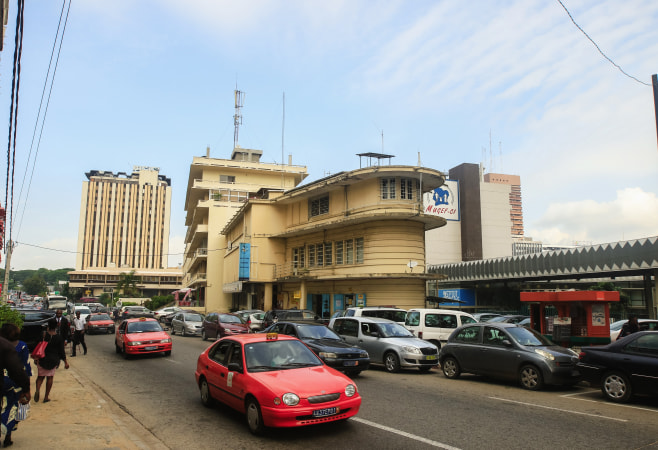Weather in Abidjan, Côte d’Ivoire – Best Time to Visit the City
Abidjan, the vibrant economic hub of Ivory Coast, is known for its bustling markets, stunning lagoons, and rich cultural heritage. Whether you're planning a trip or living in this dynamic city, understanding the weather in Abidjan is essential for making the most of your time. This guide provides detailed insights into Abidjan’s climate, seasonal patterns, and practical tips to help you prepare, ensuring your experience is both enjoyable and stress-free.
 Check the current weather in Abidjan, Ivory Coast, for your planned trip
Check the current weather in Abidjan, Ivory Coast, for your planned trip
Overview of Abidjan’s Climate
There in Abidjan, the tropical wet and dry climate (Köppen classification: Aw) is marked by its high humidity, distinctly wet and dry seasons, and warm average temperatures. The city is located on the southern coast of Ivory Coast, along the Gulf of Guinea. It experiences relatively consistent warmth all year round, with temperatures generally ranging from 24°C to 32°C (75°F to 90°F). Its weather is heavily influenced by both location--it lies right at the edge of this west African coastline - and the West African monsoon.
Key Climate Features:
- Temperature: Average highs of 28–32°C (82–90°F) and lows of 22–26°C (72–79°F).
- Humidity: High, often upwards of 80%, especially during the wet season.
- Rainfall: Heavy during the wet season, even up to 2000 mm annually.
- Seasons: There are two main seasons in Abidjan—wet (April to October) and dry (November through March).
Seasonal Breakdown of Weather in Abidjan
Wet Season (April to October)
Expect some showers in the morning, but sunny afternoons are still common. With highs between 25–30°C (77–86°F) and lows of 20–25°C (68–77°F), this is an area that may reward you with a small shower or two by morning, yet nothing too disruptive. You would do well to prepare accordingly: Warm, with highs between 25–27°C and lows at about 20°C. In the late afternoon, rains are also common--one minute it looks like clear skies ahead, only to be suddenly drenched an hour later by unexpected downpours.
Heartfelt Tips for Visitors:
Please bring a cap or umbrella that can be folded away into your pocket for rainy days. Here are some strategies.
- To avoid a rainy outdoor activity after the rain, start your day early.
- If you're interested in outdoor pursuits in this city, check local flood warnings.
The Dry Season (November to March)
During the dry season, Abidjan has sunny weather, low humidity, and a nice breeze. This is precisely the best time to take a trip to Abidjan because you don't need vehicle air conditioning.
- Average Rainfall: A month could see less than 50 mm of rain in some cases.
- Average Temperature: The heat of summer reaches peaks at 30–32°C (86–90°F) in the daytime and cools off to 24–26°C (75–79°F) from dusk till dawn.
- Condition: Clear skies and warm weather are the order of the day, but around December-January, occasional harmattan winds from the dry, dusty Sahara can blow up dust into your company, which may cause discomfort if it gets into your shoes or eyes.
Tips for Visitors:
In a bid to protect yourself from those strong UV rays, take along sunscreen, sunglasses, and a hat.
Stay hydrated, but avoid overdrinking during the heat of the day.
Explore outdoor attractions like Banco National Park or the beaches, waiting for your next visit to Abidjan during this season.
Short Dry And Wet Periods
Abidjan also has short intervening periods:
- The Short Dry Season (August to September) offers a break in the rainy spell as relatively fine weather prevails.
- The Short Wet Season (October to November) – Less sun, more gloom (rainfall increasing) beckons in upon prolonged fine weather as the next long period of sunshine gives way to rain.
 Learn about Abidjan’s tropical climate, rainy and dry seasons, and the best months for travel based on the weather.
Learn about Abidjan’s tropical climate, rainy and dry seasons, and the best months for travel based on the weather.
Monthly Weather in Abidjan for January
January – Pleasurable Dryness
- Temp: 25-31°C(77-88°F)
- Rainfall: Low
- Ideally, you need a guide for this month when tourists seek press coverage, sunny skies with lower humidity, and the beach month is February.
February – Warmer and Still Dry
- Temp: 26-32°C (79-90°F)
- Temperatures rise slightly, though daylight hours begin to shorten. March – Heat Starts to Build Up Temp: 26-33°C (79-91°F)
- The humidity begins to rise, a sign of the future rainy season. Use sun protection and stay hydrated.
April – Beginning of Rainy Season
- Temperature: 25–32°C (77–90°F)
- Rains increase in frequency, and afternoon showers often arrive without warning.
May to July – Heavy Rains
- Temperature: 24–30°C (75–86°F)
- Long periods of continuous rain and overcast skies. Roads become very slippery, so make sure to wear proper shoes.
August – Brief Cool Period
- Temperature: 24–29°C (75–84°F)
- A brief, cooler period with less rainfall. Good time to visit around the city.
September to October – Short Rains
- Temperature: 24–30°C (75–86°F)
- The rains are back. Pack a light raincoat or an umbrella for little drizzles.
November – Transitional Period
- Temperature: 25–31°C (77–88°F)
- Lesser rain. Find a little time to wander through reserves or beaches before peak tourism season starts.
December – Cool & Dry
- Temperature: 24–31°C (75–88°F)
- The weather is comfortably cool, with a low chance of rain and cooler breezes. A popular month for tourists.
- Figures are based on data from weather records.
Best Time to Visit Abidjan
The dry season (November to March) is best for visiting Abidjan, as the weather is suitable for enjoying outdoor activities such as exploring the Plateau district, seeing St. Paul's Cathedral, or lazing on some nearby beach.
December to February is especially ideal, as the weather is fine and comfortable for travel. This is the best time for sightseeing, market visiting, or participating in one of your favorite local festivals. This period is also a good time of year to attend local arts events and venues like MASA (International Market for Arts and Entertainment.
May and September offer lush greenery during the rainy season—perfect for nature lovers who don’t mind occasional showers.
August and early autumn are good times for budget travelers when the crowds are thin after the end of the rainy season, but it's still quite dry enough as compared to spring or early summer.

Plan your trip or day with accurate temperature and rain predictions.
How Weather Shapes Abidjan’s Culture and Way of Life
Cuisine - In the rainy season, bring yams and plantains to your local market for fresh produce. For the dry season, dried fish or grilled fish in attiéké (fermented cassava paste) would be best from a street food man with bamboo coals cooking up supper.
Festivals - In the dry season are major events such as the Fête du Dipri (April, just before the wet season) and Christmas. Festivities take advantage of clear skies.
Daily Life - Citizens avoid the wet season’s rain by arranging their activities for early in the day. Drainage problems, such as those that led to this year’s flooding, will put a damper on things in the dry season.
Practical Tips for Dealing with Abidjan’s Weather
What to Wear in Abidjan:
Dry season: Go with lightweight clothing like cotton, sunglasses, hats, and sunscreen
Rainy season: Waterproof boots, a travel umbrella, and light cover-up clothing to avoid mosquito bites
Health Precautions:
Always carry mosquito repellent, especially during the wet season when the risk of mosquito-borne diseases like malaria is higher.
Don’t overdo sun exposure or dehydration. Avoid heatstroke by drinking water consistently throughout the day rather than consuming large amounts at once.
Transport:
During the rainy season, traffic in Abidjan may be disrupted by flooding: Use ride-hailing apps like Yango or factor extra time into your journey.
Some neighborhoods and outskirts are more prone to flooding during the harmattan or heavy rains, so plan your route accordingly. As soon as we go out, you can find yourself knee-deep in water without an umbrella, and you may find yourself drenched and stranded.
Activities:
- Wet Season: There is plenty to see and do within the confines of buildings such as the National Museum of Abidjan or local art galleries.
- Dry season - Take advantage of outdoor markets, lagoon tours, and beach activities at Assinie or Grand-Bassam.
Weather Forecast Resources for Abidjan
To stay abreast of the weather in Abidjan, make use of reliable sources:
- AccuWeather - Includes detailed information on hourly as well as 10-day forecasts for Abidjan.
- BBC Weather offers clear and easy-to-read summaries with precipitation maps. Go by this guide for the general forecast of the weather to be expected.
- MeteoBlue: Goes beyond temperature, giving humidity and wind speed data. This is useful in planning an outdoor activity around town.
- Local Apps - Download an App like “Weather Underground” or “Meteo CI” specifically for Ivory Coast updates, as well as general forecasts from AccuWeather, BBC Weather, and MeteoBlue. Afterwards, just pick one app carefully as you would a suit out of all available options.
Pro Tip - Keep checking forecasts a few days ahead of time, because tropical weather has many surprises even when we think our information is up-to-date. In the last sentence of the above paragraph, this concern is reinforced with specific reference to “tropical” weather, which is in fact our only reliable topic for immediate weekend forecast writing.
FAQs About Abidjan’s Weather
Does Abidjan have both hurricane and typhoon seasons?
Abidjan isn't a place where you can experience hurricanes. It hardly ever goes through anything severe, and when it does, it's only against other rules of nature.
Does Abidjan have a winter?
No, Abidjan has no winter. The city's climate is tropical all year round!
Which month is the hottest in Abidjan?
Abidjan's hottest month varies, but March is usually the winner. In March:
- Average daytime temperatures are 33°C (91°F).
- Humidity starts to climb, in preparation for the rainy season; it actually feels warmer still.
- Nights are warm, with lows ranging in the mid-70s but jumping to the low 80s by morning.
Conclusion
Understanding the weather in Abidjan is key to planning a successful trip or navigating daily life in this bustling city. The dry season (November to March) offers the best conditions for exploring, while the wet season (April to October) requires preparation for rain and humidity. By packing appropriately, checking forecasts, and timing your activities, you can fully enjoy Abidjan’s charm, from its stunning coastline to its vibrant markets.
Have you visited Abidjan or experienced its tropical climate? Share your tips in the comments below, and don’t forget to check the latest weather updates before your trip!
Related Articles
- Ivory Coast Birdwatching: Where Are Best Spots & Species
- Top Kitesurfing Spots in Ivory Coast: Where and When
- Ivory Coast Visa and Travel Advisory Updates for Tourists
- Ivory Coast Desserts: Must-Try Dishes for Travelers
- Top African Airports Every Traveler Should Know
- Visa-Free Travel to the Ivory Coast - Things to Know
- Top Outdoor Activities to Experience in the Ivory Coast
- Top Must-Do Activities in the Man Region You Can’t Miss
- Best eSIM for Ivory Coast Travel: Everything You Need to Know
- Hiking Mount Nimba: Trails, Wildlife, and Conservation Info
HOW CAN WE HELP?
APPLY WITH CONFIDENCE
|











